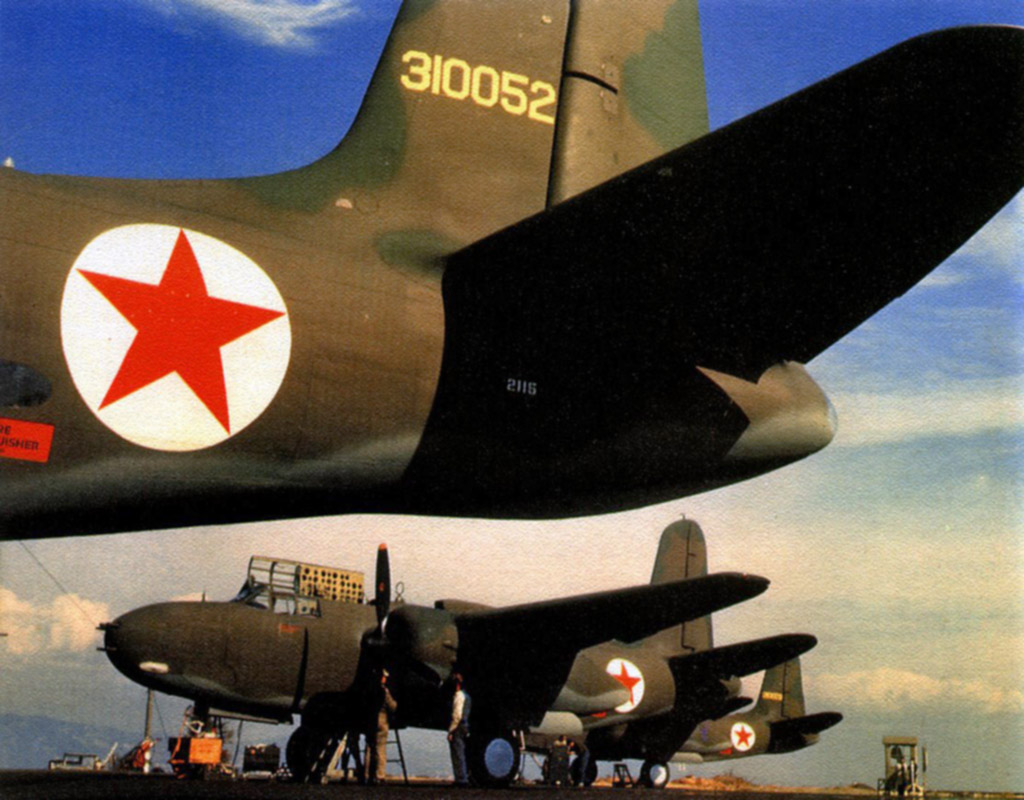
|
|
Updated on January 8, 2022
| |

In September 1939, a Soviet delegation led by Lukashev went to the U.S. to negotiate the acquisition of DB-7, considered similar to SB but more advanced and performing. It could have been useful to be studied by Soviet designers. Douglas agreed to sell the planes, but in a batch of at least ten and without weapons or military equipment. After insistence, Douglas agreed to sell 10 DB-7 with equipment, weapons and the license and assistance to start the production of the type in Soviet Union. The outbreak of the war with Finland caused the opposition of the U.S. President Roosevelt that promoted a 'moral embargo' to military supplies to S.U., so all contracts were broken and the project of acquisition of the type failed. Things radically changed after Barbarossa; the governments of the U.S. and United Kingdom decided to provide military assistance to the Soviet Union. At the conference of Allied Delegations held in Moscow in September 1941, the DB-7/A-20 was required. The plane was seen as a short-range bomber. The number of A-20 to deliver was initially set as 584, but it grew to 828, of which 300 were from orders placed by the U.K.
|
|||
From DB-7B, Boston III, A-20 A,B,C to B-3 The shipment of the A-20 began in late December 1941, and within 1941 3 planes were sent by Northern ship convoys, 41 through Iran and Iraq. These planes were transported by ship at Basra, in Iraq, and then at the nearby British base of Shuaiba where they started to arrive in early 1942; they were assembled and remarked there, then accepted by a Soviet commission. Until May, 92 B-3 were assembled and ferried by Soviet crews to the 4th reserve brigade in Azerbaijan. Initially, they were Boston III produced for the U.K., many still factory new, someone already utilized, plus some similar DB-7B built for France and DB-7C built for Holland. Soviets usually referred as B-3 both the British version Boston III , DB-7 B and C, and the similar versions A-20B and A-20C sent from the U.S.; the U.S. names A-20 or Havoc, instead, were never used for these versions. Right: the photo shows an A-20B (close) and a A-20A/DB-7B/Boston III (on the background , not an A-20C). They are distinguishable for the different glazing of the nose and for the different arrangement of the exhaust tubes, and for the presence of large machine guns blisters on Boston III. All these types were referred as B-3 or Boston in the Soviet Air Force and Navy. Image from 'Bostony v Sovetskom Soyuze' of Vladimir Kotelnikov |
|
||
Later, the A-20s were transported in already assembled form on converted tankers; later again, after the establishment of an intermediate base in the island of Ascension in the Southern Atlantic Ocean, they were ferried in flight from Florida to Brazil, to Ascension, to West Africa and from there to Abadan or Teheran where they were prepared, remarked by US personnel and then taken by Soviet crews. Right: ex-British Boston III and Soviet crew in training in Central Asia, August 1942. The plane is unusually carrying both the British code BZ590 in black on the fuselage and the U.S. number 119608 (A-20C-BO) on the tail, and has already received red stars with black outline on the fuselage and a number 5, probably red with a lighter outline, scarcely visible on its rudder. Image from Red Stars 4, of Geust and Petrov, ed. Apali
|
|
||
There was some difficulty in training the Soviet crews because A-20 hadn't a training version: double commands were provided in the gunner's cockpit, but they were unuseful because he hadn't visibility forwards. So some conversions with double commands installed in navigator's cockpits in the noses were made, and called UB-3 (later, UA-20 if obtained from A-20G). The 794th Bomber Regiment (BAP) was the first to receive 22 B-3 in March 1942. Some training was made on B-25s because they had side by side pilots and allowed to familiarize with some characteristics as the landing gear and units of the instruments before passing to fly B-3s.
At the end of May, there were already 11 regiments equipped with A-20, and 6 of them became fully operative in early July 1942. At the beginning, Bostons were utilized foremost on the southern front. Bostons gained quickly a good reputation. When compared to Pe-2s with similarly high performances, they were much more reliable and easier to fly. Besides the cabins were comfortable, spacious, heated and with good visibility. The instruments and equipments were excellent, only the radio compass lacked and was sometimes installed by Soviets in non-standardized ways. Right: B-25D in Soviet markings. These planes, although having a similar look to A-20, were bigger and had side-by-side pilot seats; this allowed their use as trainers, to familiarize the Soviet pilots with American instruments and units before passing to B-3s. Image from http://ava.org.ru/bp/13g.htm
|
|
||
The original armament of B-3 A defect of Bostons was their vulnerability, particularly to attacks from behind by German fighters, and led to high losses. The lethality of their small 7.7 or 7.62 mm machine guns was insufficient to create a good defense, and they had a too limited field of fire. The problem had already ben noted by British. Standard DB-7/Boston/A-20A/B/C had both a dorsal position for a machine gun (before type A-20 G-15, then a turret was installed as factory standard), both a ventral position. They were armed with Vickers 7.7 mm machine guns for British Boston III, with Browning 7.62 mm for A-20 B (twin MG in dorsal position) and with Browning 12.7 mm for A-20C and later. The crew of the DB-7/Boston III/A-20A-B-C in England and the United
States consisted of three people: a pilot, a navigator-bombardier and
a radio operator-rear gunner that actioned both the dorsal weapons and
the one firing through the ventral hatch. The lower installation was closed by a double-leaf hatch that opened inwards. Right; standard defensive armament of Bostons/A-20 early type. |
Images from https://paulbudzik.com/models/amt-a20-Havoc/amt-a20-havoc-build-pg2.html |
||
|
Soviet rearmament of B-3s In Soviet Union, some B-3 were rearmed with the MV-3 turret with 7.62 mm ShKAS; they had a wide field of fire, but this wasn't enough because of the insufficient lethality of small caliber machine guns. More usually, B-3s (and early A-20G) were rearmed with the UTK-1 turret with a Soviet UBT 12.7 mm machine gun with K-8T or PMP sight and a prominent side magazine with 200 rounds.
Below: UTK-1 turret with UBT 12.7 mm machine gun. Note the wide magazine on the right side of the gunner. Image from Red Stars 4, of Geust and Petrov.
|
As an alternative, plant No. 43 supplied the UTK-1 with a Colt-Browning 12.7 mm machine gun with a K-8T sight. In this case, the ammunition consisted of 12 magazines of 30 rounds each. On 24 September 1942, it was approved a scheme of rearmament proposed by the design team (OKB) of plant n.43: two fixed UBT on the nose sides, a turret UBK-1 with a UBT and a further UBT in the ventral hatch, with a mount as on Pe-2. For the end of 1942, 96 Bostons were rearmed in plant n.43. It was planified to rearm 225 planes, but it was impossible to retire so many ones from the front, so conversion kits were sent to the units to prosecute the conversion work.
Below: UTK-1 turret with the Colt-Browning M2 installed in. This variant rarely appears on photos. Image from Red Stars 4, of Geust and Petrov.
|
||
|
|
||
Plant 81 began to improve the armour and studied removable front shields with movable shutters to protect the engines from snow during winter operations, vaguely similar to those of I-153 and Li-2s ; they were mass produced by Factory no.2. All these modifications led to an increase in weight and some loss of performances.
Right: the Crew of Senior Sergeant A. Volodichev in front to their A-20B, Voronezh Front, March 1943. The Soviet-made shutter plate is well visible. Image from 'Bostony v Sovetskom Soyuze' of Vladimir Kotelnikov |
|
||
The original DB-7/Boston III/A-20A/B/C had only 4 fittings inside the bomb bay, greatly reducing bomb load when smaller bombs were fitted. The maximunm internal bomb load was reached when 4 x 227 kg bombs were loaded. Besides, Soviet bombs didn't fit well to the original suspension points. The Soviet Factory n.43 modified the B-3 supplied to S.U. in summer 1942:
In autumn 1942, a big number of A-20Bs was delivered by US for land-lease purposes. U.S. forces weren't satisfied with this type for the lack of self sealing fuels and of armor protection, so gave away the most part of their production. These new stocks of B-3 were modified in improved way:
Thanks to the Der-21 bomb boxes, the A-20B could carry many types of specialized bombs, as containers KMB-Pe-2 with small explosive bombs: 60 x AO-2,5, or 18 x AO-10, or 8 x AO-25, or 60 x incendiary ZAB-2,5, or 64 ampoules of AS or AS-2C self-igniting liquid; alternatively, 4 Der-19p for 4 x up to 250 kg bombs could be installed in the bomb bay. When FAB-250 were carried, the flaps couldn't be fully lowered. Using both the bomb bay and the wing pylons, the maximum bomb load raised to 2000 kg (20 x FAB-100, or 8 x FAB-250, or combinations) while taking off from concrete runways; for operations from field conditions, the bomb load was reduced according to the airfield conditions.
|
|
||
As a factory option, four bomb racks could be installed under the wings. Below, we see a drawing of the original racks.
Right: the racks were adapted for Soviet bombs FAB-50, FAB-50TSK, FAB-100, FAB-100TSK, FAB-250TSK. When the FAB-250TSK were suspended on underwing racks, the flaps couldn't be fully lowered The photo on the right shows the modified racks with long adjustable screws of different length. bombs were raised up to the underwing racks using winches. |
Image from 'Bostony v Sovetskom Soyuze' of Vladimir Kotelnikov |
||
The primitive British Wimperis D-8 gunsight, which was put on export planes instead of the highly advanced Norden for secrecy reasons, was replaced by Soviet OPB-1R (daytime) or NKPB-4 or 7 (for night bombing) sights. Link to Page 2 of USSR optical devices Torpedo carriers additionally received sights for torpedo-throwing PTN-5 (the same of Tu-2), installed in the navigator cockpit in the nose, or VL-1, installed in the pilot's cockpit when the navigator was placed behind the gunner's position. Right: the navigator of a A-20B. The bomb sight is a Soviet-made NKPB
|
|
||
Schematic of the installation of recce cameras in the bomb bay of a B-3 and of their controls in the navigator's cockpit. The arrow with NP is for 'forward'. From an old unidentified book, via Daniele Righi Fig. 140. Diagram of the equipment of the reconnaissance aircraft two aerial cameras in a dual photo installation:
|
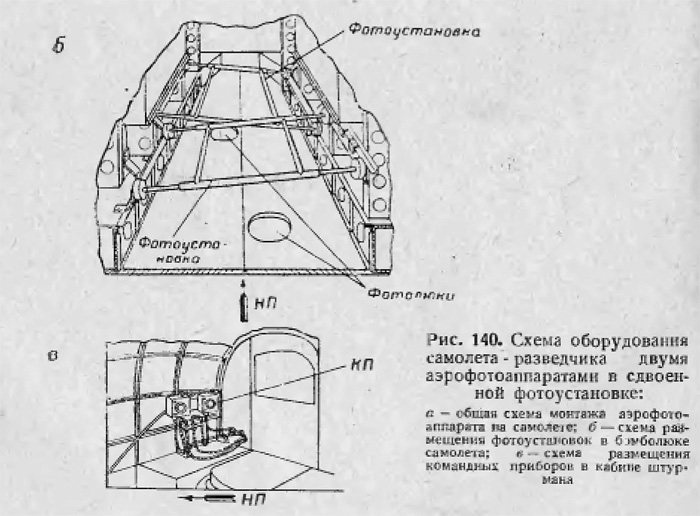 |
||
A-20G in Soviet Union (A-20Zh) The first A-20G became operative in Soviet Union in the summer of 1943, where it was known as 'A-20 Zh', no more B-3. The first series, G-1, were armed with an offensive armament of 4 x 20 mm guns and 2 x 12.7 mm machine guns in their nose, and had not a turret, but a 12.7 mm machine gun in dorsal position and a 7.62 mm one in ventral position. The guns were scarcely accurate and deemed unsatisfying by USAAF; nearly all A-20G-1 were sent to Soviet Union. The few available photos of these variants are foremost of Soviet planes. In U.S., this version with solid nose with strong fixed armament and crew of 2 was considered as a ground attack plane, and part of them were utilized in this way in S.U. too, ex. by 449 BAP. Anyway, Il-2s were considered preferable for this role because they were much more armoured and less vulnerable to German ground fire, that was very accurate. So the A-20 Zh were utilized in many different roles, as day and night bomber, heavy fighter, night fighter, escort night fighter to suppress AA, reconnaissance plane, torpedo bomber, minelayer and even transport plane. For many of these uses, the planes needed to be modified.
Right: two images of A-20G-1-DO at the NII VVS. The serial seems to be 42-353.. Images from Red Stars 4 of Geust and Petrov |
|
||
A-20Zh night intruders Since autumn 1943, A-20Zh were used by 113 AP (that was made Guards as 27 GAP on 10 January 1944) as night fighters/intruders to escort the night bombers of the ADD (Long Range Aviation) and suppress the AA defenses. they were armed with their nose guns and often with underwing rockets, not visible on available photos. Their emblem was a white lightning. The unit was attached to the 4 GAK (Guards Air Corpus) of ADD, equipped with B-25 Mitchell that were apt for long range night bombing. Right: planes of 27 GAP were used to suppress the AA defenses. during night raids. They were characterized by a white bolt painted on their sides. Image: archive Zaika.
|
|
||
This interesting sketch was made by a Finnish technician in October 1943. It depicts the internal layout of a Soviet A-20, probably a night intruder of ADD because the 20 mm guns are describes. The drawing puts into evidence the steel armour, the dural armors and the fuel tanks. We can see that the whole bombs bay was occupied by fuel tanks. All the explosive load of the plane was external; it could have been equipped with underwing rockets. Drawing from https://www.flightforum.fi/topic/30561-douglas-a-20-havoc-l%C3%B6ytynyt/#comment-735317 via Tapani Tuomanen |
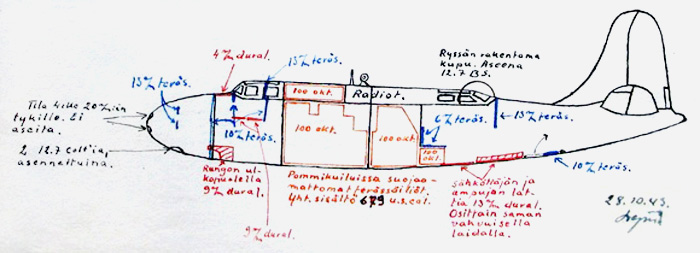 |
||
|
A-20Zh AKAB One A-20G-1 was equipped with a ventral battery called AKAB: two ShVAK guns and two UBK machine guns were mounted in the bomb bay. Their ammunition (440 rounds and 340 rounds) was placed in the former cabin of the radio operator gunner. The flight crew consisted of a pilot and a navigator. When firing to a selected target, electromechanical actuators moved the guns downwards continuing to hit the selected target while the plane was overflying it. Tests on the AKAB-equipped plane were made in the spring of 1944. In the summer, it was transferred to the 27th GAP for military testing. On the night of June 28, the plane flown by Captain Krapiva took part to a raid on the airfield of Baranovichi and destroyed two German planes before being damaged by by AA fire. It was then ordered to install the AKAB on six A-20Gs, but it seems that this was never done.
Right:: the AKAB system, with its barrels protruding from under the fuselage, can be seen on plane 10 of 27 gap. Image from Red Stars 4 of Geust and Petrov
|
|
||
|
Right: Diagram of the AKAB system on a A-20G-1. Left: detail of AKAB with the cover panel removed. |
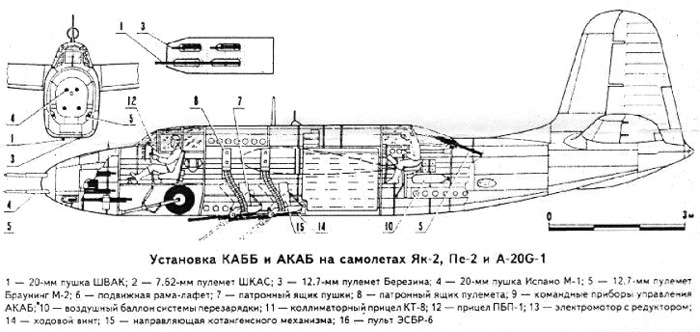 |
|
A-20G-5 and successive series Starting with A-20G-5 series (for some reasons, series were numbered 1, 5, 10, 15, 20 etc.), the 20 mm guns were replaced by 12.7 mm Browning machine guns, well distinguishable because much less protruding. The machine gun in ventral position still was 7.62 mm Browning, unless Soviet replaced it with a more powerful weapon.
A-20G-10-DO no.42-53914 (253914 painted on the tail) was tested at NII VVS. Starting with A-20G-5 series, the 20 mm guns were replaced by 12.7 mm machine guns on the production line. Image from Red Stars 4, of Geust and Petrov, ed. Apali. |
|
||
| A ground crew is loading bombs on the original pylons of an A-20G, different from those of earlier versions. These pylons were rarely installed on Soviet A-20G. |
|
||
A-20s with radar
In 1943, Gnejs-2 radars were tested on some B-3, both for aircraft and ship localization. Gnejs-2 aerials appeared as rods disposed in trio:
From the few available photos, seems that other configurations were possible.
Right, above and mid: two images of a Boston III night fighter equipped with Gnejs-2 radar tested by Maj. Sakharov at NII VVS between 27 January and 20 June 1943. Images from: Red army air force radar fighters
|
|
||
Right: A-20B with Gnejs-2 aerials recognizable under the left wing. The number seems a red 9 outlined in white, the serial on the tail seems 13498. Aerials on the nose are not visible, but one can assume they were. Image: D. Linevich |
|
||
A-20Zh radar fighters
In May 1943, the Air Defense Fighter Aviation Command (IA-PVO) requested 27 A-20 equipped with radar as night interceptors, but factory No. 81, overloaded with orders, wasn't able to comply, so only 6 of these planes were delivered to the PVO, some of which were adaptations from B-3 (Boston III and A-20B). For some reason, priority was given to the Long Range Aviation. On July 1944, the long range night fighter division 56 IAD (45 and 173 IAP) was formed, equipped with A-20G-1, initially equipped with Gnejs-2 radar installed in Zavod 81. The planes had a pilot, a radar/radio operator sitting in the gunner's cockpit and a navigator sitting behind it, with two additional rectangular windows on each side but no any cupola, differently from what can be seen on torpedo bombers of the Navy. They were equipped with additional 1036 liter fuel tanks in the bomb bays, that gave a flight duration up to 8 hours. At the beginning, the operativity of the unit was deluding, losing many planes in accidents without shooting down any enemy plane. After replacing the commander of the division and making improvements in the equipment and in methods during a stop in winter 1945, the unit returned in action obtained some success in March 1945, contrasting the air supplies to German units encircled in the Breslau region and shooting down some enemy planes and transport gliders. No photos are available of A-20G-1 of these units with the Gnejs-2 radar, but they are described as standard with OD undersurfaces (probably with the usual MG blotches or bands) and NG undersurfaces, and white two-digits numbers (in 45 IAP, from 01 to 32) on the fin, over the usual yellow serial. In 1944, it was created the 39 night fighter air regiment of the Black Sea Fleet, equipped with A-20G with Gnejss-2 radar. It didn't take part to any combat action. At the war's end, it was stationed in Saki airfield.
|
Images from: Red army air force radar fighters |
||
...........................Legenda:......................................
. |
|
||
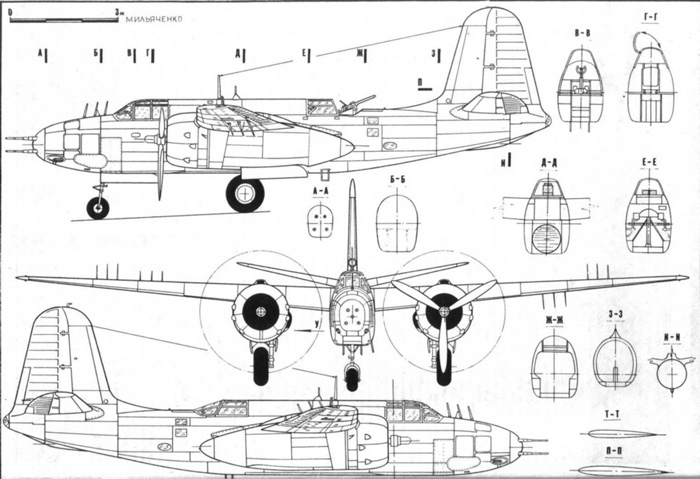 |
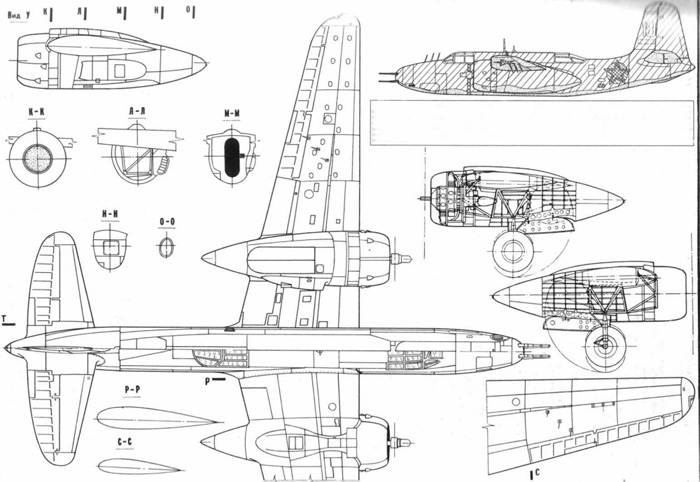 |
||
A-20Zh with Gnejs-3 radars. Plane black 10 (42-53869) was a A-20G-10-DO rearmed with the 20 mm guns of earlier A-20G-1. It was photographed in spring 1945 at Factory n.81 in Monino, where the conversion to night fighters was made. The plane is equipped with Gnejs-3 radar, whose aerials look different from those of earlier Gnejs-2. Besides it was equipped with a TV to visualize the radar signal to the pilot to improve coordination with the radar operator. The Gnejs-3 radar included:
See also: |
Images from Red Stars 4 of Geust and Petrov. |
||
A-20G-20 and successive series On the G-20 series, a power-driven Martin 250GE turret fitted with two 12.7 mm machine guns was fitted, with the fuselage15 cm wider in its upper part around the turret, and the ventral tunnel gun changed from a 7.7 mm to another 12.7 mm Browning. The engines were two 1,600 hp R-2600-23. The A-20G was delivered from February 1943 and was the most produced version, with 2850 built. It is very difficult, perhaps impossible, to find a photo of a Soviet A-20G-20 in its original form, because them all were modified with the addition of a navigator cockpit in different ways. A-20G became quickly the most common version of this plane in Soviet service. All them were delivered in 1943 and 1944. After A-20G, some A-20H were delivered in 1944. They were visually similar to late A-20G, but equipped with the 1,700 hp R-2600-29. Right: These planes under the snow, still in unmodified form, are waiting to be flown to Soviet Union through the Alaska-Siberia route, at Lake Field in winter 1943. Image from 'Bostony v Sovetskom Soyuze' of Vladimir Kotelnikov |
|
||
A-20Zh modified to add a navigator cockpit (VVS) The lack of a navigator was a severe handicap for the use as bomber, torpedo bomber and minelayer. In U.S, derivatives of the A-20G with a cockpit for a navigator fitted in a newly shaped glazed nose, A-20J and K, were built in limited number and foremost used as leader planes in bombing units equipped with A-20G, that drop bombs when the leader ordered. Such versions would have been welcome for the uses that Soviets made, but they were supplied late, in 1944 and 1945, and in limited numbers. So, A-20G were often modified in Soviet Union to obtain a cockpit for
a navigator, both in the Air Force and in the Navy service. |
|||
Air Force, modification 1
|
In October 1943, at factory No. 456, one A-20G as fitted with a small navigator's cockpit in the bulkhead of the forward bomb bay. partially removing the partition separating it from the pilot's cockpit was partially removed, and the sides were closed by plywood giving a small space of about 70x70 cm. The navigator was sitting on a folding seat, while the parachute didn't fit properly. Next to it was an OPB-1 bomb sight, an ESBR-6 bomb reader, a compass, a board with basic instruments, and an oxygen device KPA-Zbis. Some windows were cut into the sides of the cabin. Aside we see some images where both the windows cut on the side and those on the top are visible. Three small windows were opened on each side, and eight windows were opened on the top, on the access panel. This solution was very poor due to the lack of space, visibility and of emergency escape. Some A-20G were modified in this way, but many of them were soon furtherly modified with a new cabin installed on the nose, often preserving the glazing of the rear of the pilot. |
||
Air Force, modification 2
|
The second solution of the Air Force was far better, removing the upper four weapons from the nose and making space for a cabin that wasn't too different from that of the earlier versions of A-20/Boston (B-3), but with less glazing. Three windows were opened on each nose side, and one in ventral position. The front cupola vaguely resembles that of B-3 and was characterized by a pentagonal flat glass on its lower half. Many, but not all, the planes that received this type of nose had already received the unsuccessful navigator cockpit behind the pilot; the glazing on the rear was preserved even if the rear cockpit was no longer used. |
||
|
Air Force, modification 3
|
The third variant of the modification was similar to the second one, but differed for the presence of 4 windows instead of 3 on each nose side, and for the different frames of the front cupola, with a smaller and curved flat window, instead of pentagonal, on its lower part. Again we can see a flat window below the fuselage front. It is not clear if this variation of the nose work was an earlier or later variant of the second one; on the available photos it is never associated with the glazing behind the pilot's cockpit.
|
||
|
|||
|
B-3 in Navy service Bostons III and A-20B were delivered to the Navy at the same time of the Air Force, but they were scarcely useful in this role due to their limited radius of action (1,380 km, less than a Pe-2) and the impossibility to carry large bombs able to destroy ships. In the Baltic fleet, these planes were used foremost as reconnaissance planes. B-3 were utilized as bombers in the Black Sea against harbors and airports, but they could bomb only in horizontal flight, not on dive, so they were scarcely able to hit moving ships. Right: A-20B of 15 ORAP, VVS KBF, utilized as reconnaissance plane over the Baltic Sea. Image from Red Stars 4 of geust and Petrov, ed. Apali. |
|
||
The big success of A-20s in the Soviet Navy was when they were converted into torpedo bombers. Being impossible to load the long Soviet torpedoes into the bomb bay, Soviet developed external structures called 'torpedo bridges' that were located on both sides of the fuselage. They consisted in two-T beams with wooden fairings at the ends, connected to a bridge spacer beam passing across the bomb bay; vertical rods connected the bridges with the lower surface of the wings, close to their roots. 2 T-18 torpedo holders were attached to the beams. The original underwing racks were removed. The first tests were made in March 1943 on a DB-3C modified in Factory 81, specialized in modifications to foreign-built planes. Later, starting from August 1943, Factory 89 converted some A-20Bs as torpedo bombers with the bridge; two UBK 12.7 mm machine guns with 250 rounds each were installed on the nose sides instead of the original 7.62 mm machine guns; the pilot had a K-8T gunsight, and the navigator had a NKPB-4 night bombing sight and a PTK-5 torpedo sight. Below: drawings showing:
|
|
||
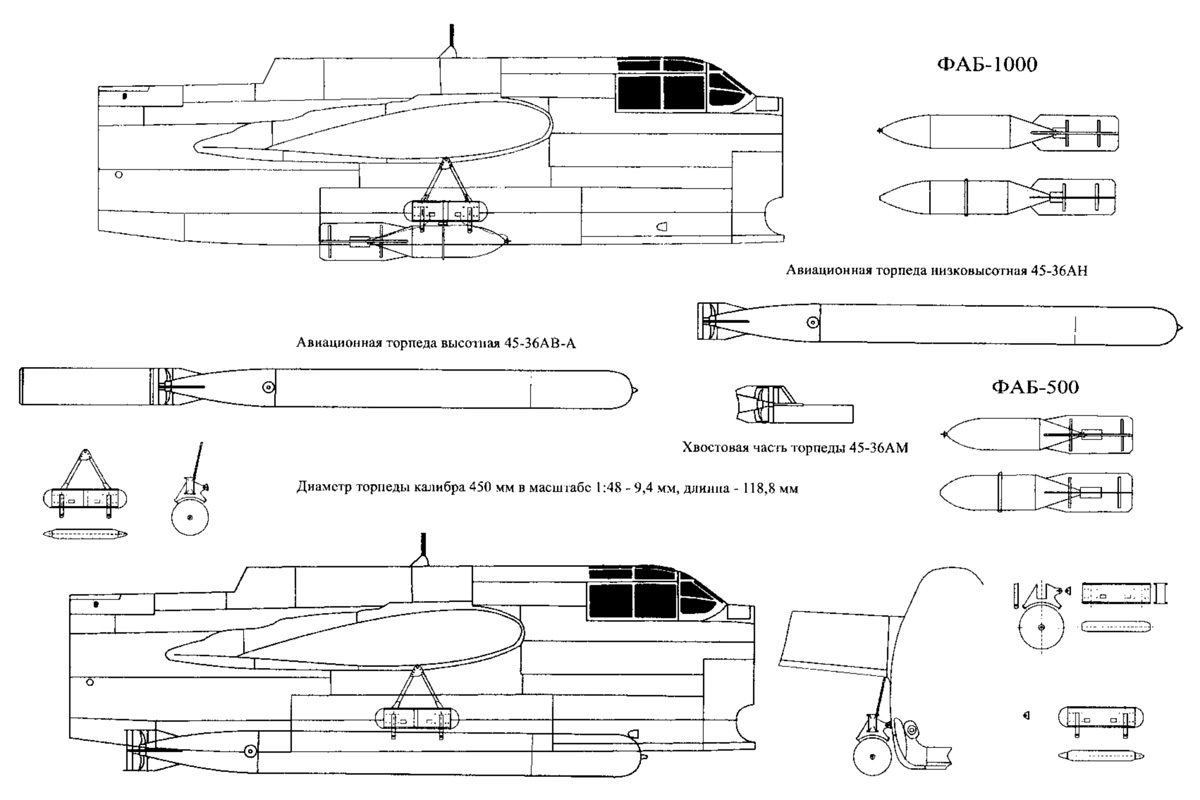 |
|||
The defensive armament was remade, with the installation of the UTK-4 turret and the modified Pe-2 installation on the ventral hatch, both armed with UBT machine guns. Additional tanks were installed in the bomb bay, usually not of the U.S. type that were unprotected, but of the type used on Pe-2s, suspended on belts; variants were possible due to the availability of parts. Tanks from Hampden were utilized too, and an inert gas system was installed, with the CO2 bottle under the navigator's seat, and the valve and pressure gauge were kept by the pilot. The oxygen system and the intercom were changed with Soviet ones. Bombs and torpedoes were dropped from various devices: bombs from ESBR-3, torpedoes from ESBR-6. Bomb armament had two options: in one, original bomb racks could have been preserved in the rear part of the bomb bay, for a pair of FAB-100. In the second option, Soviet Der-21 cassettes were placed instead of the American bomb holders, and the bomb load rose to 400 kg. The first converted A-20B was ready on August 9, then one each two days up to 36 planes. Right: the bridges were useful to bring large bombs too: Fab-250, 500 and 1000. On the photo, 'Za Rodinu!' (For the motherland!) is readable on the bomb.
|
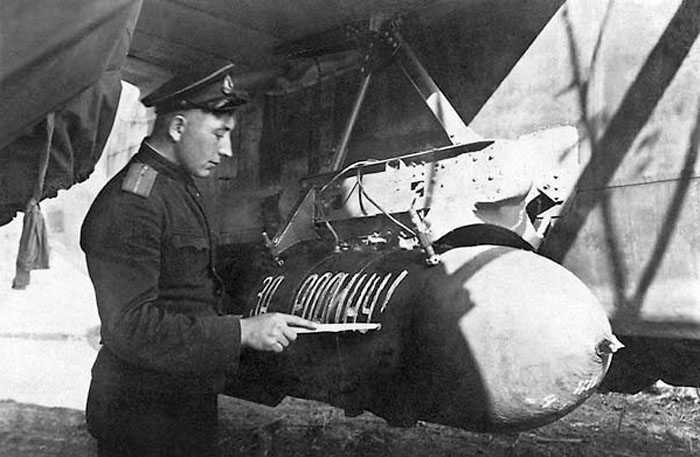 |
||
Bridges were used to carry mines:
|
|
||
A-20Zh in Navy service A-20G were more radically reworked, and in much greater number than previous versions. Apart for the bridge, the major conversion was the installation of a navigator's cabin. This could have been made in two ways:
The series from A-20G-1 to G-15 often received a 12,7 Browning MG in the ventral position instead of the original 7.62 mm; series G-20 and later already had a 12.7 machine gun in the ventral hatch. The full load of a A-20Zh with one torpedo was 11,303 kg, and this was the most usual case; rarely, A-20Zh could carry two torpedoes, with a full load weight of 11,623 kg , reducing the fuel load to not overload the landing gears. |
|
||
Navy, modification 1: raiders The easiest way chosen by the Soviet Navy to install a navigator's cockpit was putting it behind the gunner's position. A small clear cupola was installed just behind the turret, and three rectangular windows were added to each side in addition to the original oval one for the ventral mg position already present on all A-20s. The solid nose was preserved, usually with its 6 x 12.7 mm Browning M2 machine guns armament. These planes were not armed with torpedoes, but with medium/large caliber bombs suspended to the bridge. They flew in mixed formations with torpedo bombers and made the first attack on the ships trying to defeat their AA defenses. with machine guns, large bombs or a large number of 2.5 kg bomblets, just before the attack of torpedo planes. Right: the cupola and three new rectangular windows for the navigator behind the turret are visible on the photo of this navy raider Image from 'Bostony v Sovetskom Soyuze' of Vladimir Kotelnikov |
|
||
Right: A-20G n.5 of 1 GMTAB. The solid nose, the bombs bride without bombs, the added windows on the rear fuselage, the extended flaps, the white wingtips and other details are noticeable. The red stars are in symmetrical positions, but only the one under the right wing lies on an overpainted U.S. emblem. |
|
||
Navy, modification 2: torpedo bombers Torpedo bombers needed a good forward visibility for the navigator/torpedo bomber; it was necessary to remove four machine guns to create space for him, and open windows. The lower pair of 12.7 mm machine guns was preserved. This glazed nose was somewhat different from the modification made for the Air Force. 7 windows of different shape and size were put on each side, in symmetrical positions. |
|
||
The front glazing had different framing from the one of the Air Force. The Navy's style cupola, seen from the front, shows frames resembling a sort of H. There was a window on the lower surface, just after the cupola; it was a bit narrower than the ne of the Air Force variant. The available images of the right side windows are poor, but it looks that they were symmetrical to those of the left side, apart the rear low window that was split into two sliding transparent panels on the left side, and uninterrupted on the right side. This modification was seen foremost between the planes of the Northern and Baltic Fleet. From https://bellabs.ru/51/index.html and other sources.
|
|
||
Navy, modification 3: torpedo bombers An alternative style of glazed nose for the torpedo bombers of the Soviet Navy vaguely resembled the nose of Il-4s. It is not clear if this style was chronologically successive to the style 2, or it was made from another facility. This type of nose had 5 windows on each side: two vertical just behind the front cupola, and 3 a bit rearwards. Again, it is possible that a plane previously modified with the rear cockpit for the navigator to be used as bomber was later modified with the front cockpit to be used as torpedo plane; in this case the windows cut on the rear fuselage sides were overpainted, but the small cupola behind the turret was often preserved. |
|
||
The first A-20G with torpedo bridges was received by the 1st Guards Mine and Torpedo Regiment in the Baltic in March 1943, and flew aside Il-4s. In October of the same year, the 51st Regiment was formed in the Baltic Fleet, armed only with the A-20G. The 9 Guards Mine and Torpedo Air Regiment received the new A-20G, replacing Il-4s and Hampdens. In the Black Sea, the 36 Regiment received planes with torpedo bridge starting from July 1943; in April 1944 it was transferred to the Northern Fleet. The Northern Fleet utilized strike groups with about the same number of torpedo bombers with glazed nose and attack planes with solid nose; The Black Sea Fleet utilized groups of 6-10 torpedo bombers with 3-4 attack planes, that supplemented the machine guns fire with a large number of small AO-2,5 fragmentation bombs to kill the AA gunners of the attacked ships before the torpedo attack. Torpedoes were usually dropped at a distance of 600-800 m from the target, while flying at an altitude of 25-30 and a speed of 300 km/h. Right: photo of two A-20Zh of 1 GMTAP. Plane 30 is armed with a torpedo and has the navigator lodged in the glazed nose; pane 22 on the background has solid nose with machine guns, heavy bomb load and the navigator's cockpit behind the turret. Strangely, plane 30 seems to have the navigator's cupola and painted-off windows on the rear of the fuselage, sign that the conversion was made twice, probably after the loss of another glazed-nose plane in the unit. From https://bellabs.ru/51/index.html
|
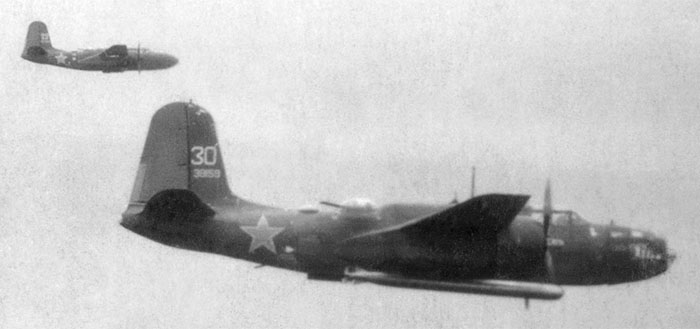 |
||
Radar-equipped A-20Zh of 1 GTMAP Radar Gnejs-2 were installed on 5 A-20Zh of the 1 GMTAP of the Baltic fleet. At first they were tested on the lake Ladoga, then the first combat mission was made on October 15, 1944 in condition of poor visibility by the regiment's commander HSU I.I.Borzov, that managed to locate a group of 3 ships in the gulf of Riga and sank one with a torpedo. After this, seven more attacks were made with the use of the radar. Right: A-20G white 6 of 1 GMTAP over the Baltic sea, 20 August 1944. The plane appears armed with a torpedo. Most interesting, the aerials of a Gnejs-2 radar are visible on the right wing, but not over the nose. It could be that the disposition of the aerials wasn't exactly the same of that seen on more well documented planes. Unfortunately, these tiny aerials often disappear in photos. Another photo of an A-20Zh of the same unit show vertical aerials under the right wing. |
Image R.Demidov archive, lend-lease.airforce.ru |
||
A-20J and K At the end, U.S. supplied 48 A-20 J and 110 A-20K with glazed nose for a navigator in 1945. The deliveries continued through the ALSIB (Alaska-Siberia) route up to the late summer 1945.
A-20K 44-718, still at the ALSIB intermediate airfield of Edmonton (Canada). It has the ferry tank under the fuselage for the ferry flight to S.U. It shows the US camouflage in OD and NG. The profile of the glazed nose is different from that of earlier versions. Surprisingly, the camouflage of the cowling appears black, and it was not a Soviet repainting. Pity that Soviet unit numbers weren't painted on yet. The most part of A-20J and K, visually identical, was assigned to the Navy. Image from 'Bostony v Sovetskom Soyuze' of Vladimir Kotelnikov |
|
||
|
|
||
Operations in Far East against Japan, August 1945 Although the constant flow of A-20 on the ALSIB route, those planes were directed to west. Siberian district, very far from the frontline, was still equipped with obsolete types as SB and DB-3. In prevision of the start of military operations against Japan, modern equipments were sent to renew the Soviet units in the Far East, including A-20 G, H, J, K. Besides, the 3x MTAP with 14 A-20G was transferred from the Northern Fleet to the Romanovka airfield. When Soviet Union declared war to Japan, 46 A-20 torpedo bombers and 12 A-20K reconnaissance planes were available; further 27 Havocs were received by the Navy up to the end of August 1945. The start of the torpedo-bomber units was slow and uncertain, only at the end they managed to contribute with some bombing raids on ground targets. Some VVS units too received Bostons, as the 903BAP of 128 MAD that received 30 A-20 K and H, utilized in operations on the Kurili islands.
|
|||
After the war After the war, A-20s remained in service for some years. The VVS started to replace them with the superior Tu-2s. Part of the planes were returned to U.S. or destroyed under their control in 1946-47. The Navy kept them in service some more years, as they were the main torpedo bombers in service; their replacement with Tu-2VS was not completed when all types were replaced by jet planes as Tu-14 in the early '50s. Some Bostons were converted as target tugs, aerial photography, communications and some served up to the mid '50s. Right: image of a A-20B-DL serial 413501 'white 29' presumably photographed after the war's end; it seems repainted with overall glossy light grey. |
|
||
| A-20s in civil service Since 1943, Bostons were occasionally utilized as transport planes by the Air Force. In 1944, some Bostons were delivered to the Civil aviation (GVF), then subordinated to the VVS. They were used to replace the ageing PS-40 and 41 (civilized SB) as fast transport planes. In 1945, 12 A-20G of the 559 BAP were delivered to the civil air force in the Moscow district and converted to carry up to 1,100 kg of load: 200 kg in the nose, 500 kg and two people in the former bomb bay, while the rear compartment lodged a radio operator, two further passengers and 200 kg cargo. An additional tank in the former bomb bay allowed a flight range up to 1,800 km. The planes bore a code starting with the letter L. Further 10 plane were passed to GVF in May, but experts of the Civil aviation concluded that the A-20 was scarcely apt to the transport role. They were gradually removed from the transport service within the end of 1946. Right: A-20G converted into transport plane. The roughly painted aluminum uppersurfaces and the windows on the nose are noteworthy. |
Image from 'Bostony v Sovetskom Soyuze' of Vladimir Kotelnikov
|
||
The Main Directorate of the Hydrometeorological Service used the A-20 for weather and ice reconnaissance. They received many batches of A-20 since 1946 for a total of 23, but they were used for a brief time only. The General Directorate of Geodesy and Cartography started to receive its first A-20s in 1946; their number grew and reached the peak of 63 planes in 1949, then they started to be written off in the '50s. Their planes carried a number starting with the letter F. Some serials of such planes were found on bibliography:
Right: : an A-20G (former torpedo bomber) of GUGK ( General Directorate of Geodesy and Cartography) aviation, 1946. The civil registration CCCP is barely visible, probably in white, under the wing, and coexists with military red stars. The painting is of difficult interpretation, probably very worn OD/MG/NG with partial repaintings in black.
|
Image from 'Bostony v Sovetskom Soyuze' of Vladimir Kotelnikov
|
||
DOUGLAS A-20 LEND LEASE TO THE SOVIET UNION SERIALS LIST
(synthetic table by Daniele Righi)
- Douglas built RAF DB - 7 : Re - appropriated by the US and then Sent
to Russia:
AL675, 695, 709, 732, 758, 761, 764, 769, 771, 772, 777, 779, 784, 788, 789,
791 to 793,
795, 796, 799, 802 to 804, 806, 811, 813 to 817, 819, 820, 822 to 832
45 aircrafts
- Boeing - built DB - 7:
AL265, 267, 281 to 283, 287, 292, 294, 295, 297, 298, 300, 302 to
316, 318, 319, 322, 323, 330
32 aircrafts
- A - 20B
: 41 - 2676 to - 2710, - 2712 to - 2770, - 2779 to - 2800, - 2802 to - 2858, - 2860 to - 2 894, - 2896 to - 2926, - 2928 to - 2942, - 2944 to - 2946, - 2948 to - 2951, - 2954 to - 2960, - 3015, - 3017 to - 3030, - 3032 to - 3047, - 3049 to - 3059, - 3061 to - 3125, - 3185 to - 3237, - 3274 to - 3294, - 3296 to - 3313, - 3315 to - 3325, - 3327 to - 3330, - 3472, - 3474 to - 347 7, - 3479, - 3480, - 3484 to - 3488, - 3490, - 3494 to - 3550, - 3552, - 3554 to - 3602, - 3604 to - 3620, - 3622 to - 3630, - 3632 to - 3638, - 3640 to - 3645, - 3647 to - 3654
647 aircrafts
- A - 20C:
41 - 19088 to - 19090, - 19092, - 19095 to - 19099, - 19101, - 19103, - 19104,
- 19106 to - 19108, - 19112, - 19114 to - 19125, - 19127, - 19128, - 19130 to
- 19136, - 19138 to - 19142, - 19144 to - 19146, - 19148 to - 19154, - 19162,
- 19164, - 19166, - 19231 to - 19299, - 19301 to - 19330, - 19332 to - 19339,
- 19341 to - 19378, - 19380 to - 19384, - 19386 to - 19421 and - 19423 to -
19461, 42 - 33150, - 33151, - 33153, - 33156 to - 33158, - 33160, - 33167, -
33169, - 33173, - 33175, - 33178, - 33181, - 33203, - 33207, - 33210, - 33214,
- 33219, - 33233, - 33234, - 33236 to - 33238, - 33240 to - 33257, - 33259 to
- 33269, - 33271, - 33273, - 33274, - 33277 to - 3327 9, - 33281 to - 33289,
- 33291. - 33292, - 33294 to - 33302, - 33304 to - 33308, - 33312, -
33316, - 33317, - 33320, - 33323 to - 33327, - 33329, - 33330, - 33332 to -
33383
690 aircrafts
A - 20G:
42 - 53544 to - 53584, - 53586 to - 53611, - 53613 to - 53699, - 53701 to - 53782, - 5378 4, - 53812 to - 53824, - 53826, - 53828 to - 53968, - 53970 to - 54015, - 54166 to - 54178, - 54180 to - 54227, - 54229 to - 54265, 54280, 42 - 86783, - 86788 to - 86790, - 86792 to - 86857, - 86859 to - 86884, - 86886, - 86887, - 86903, 43 - 9043 to - 9084, - 9086 to - 9091, -? 9093 t o - 9097, - 9099 to - 9104, - 9135 to - 9174, - 9231 to - 9258, - 9260 to - 9330, - 9504 to - 9608, - 9753 to - 9837, - 9843 to - 9848, - 9851 to - 9856, - 9918, - 10005 to - 10104, - 10141, - 10142, - 21252 to - 21291, - 21332 to - 21371, - 21392 to - 21411, - 21492 to - 21515, - 21517 to - 21531, - 21582 to - 21621, - 21662 to - 21701, - 21772 to - 21807, - 21878 to - 21931
1,447 aircrafts
A-20 H:
246, - 249, - 251, - 259, - 262, - 412, - 414, - 416 to - 418, - 426, - 428, - 430, - 438, - 443, - 446, - 449 to - 451, - 453, - 455, - 458 to - 460, - 470, - 649, - 650, - 652, - 655, - 668
30 aircrafts
A - 20J:
43 - 21858 to - 21875, - 22028 to - 22057
48 aircrafts
A - 20K:
44 - 116 to - 155, - , - 371 to - 384, - 393 to - 406, - 545 to - 559, - 583 to - 608, and - 717 to - 718
111 aircrafts
These serials amount to a total of 3049 aircrafts. According to Geust and Petrov,
a total of 2771 aircrafts were received by the URSS.
Note: According to Joe Baugher serial list, and to the serial list for A-20H
aircrafts in Wolf's book, some serials belong to A-20H planes were listed as
A-20K models on this book, for a total
of 30 A-20H and 110 A-20K.
As can be imagined , the list is not complete. Photographs exist for example
of the Boeing built 41 - 19608 with the unassigned RAF serial BZ590 in Russian
service.
Reference: - The Douglas A - 20 Havoc: From Drawing Board to Peerless Allied
Light Bomber. William Wolf , 2015 , Schiffer
Disclaimer: this work collects a lot of photos and drawings
from many sources, not always identified and mentioned.
If someone has rights on the images reproduced here, please don't feel hurted,
email to me and I shall provide to remove or to credit them.